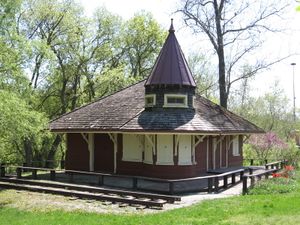Belt Line Railway
| Belt Line Railway | |
|---|---|
| Locale | Toronto, Ontario, Canada |
| Dates of operation | 1892 – 1894 |
| Track gauge | 4 ft 8½ in (1435 mm) (standard gauge) |
| Headquarters | Toronto, Ontario, Canada |
- This article is about the Belt Line Railway in Toronto, Ontario. For other uses see Beltline (disambiguation).
The Belt Line Railway was built in Toronto, Ontario, Canada in the 1890s by a railway entrepreneur, James David Edgar. It was constructed as a commuter railway line to service suburban neighbourhoods being built just north of the city. It ran through the communities of Rosedale, Moore Park, and Forest Hill, and Swansea.
It consisted of two separate loops both starting and ending at Union Station. The larger loop went east to the Don River. It turned north following the river before journeying up a steep grade through the Moore Park Ravine beside the Don Valley Brick Works. It then turned west at the north edge of the Mount Pleasant Cemetery along Merton St. At Yonge Street it turned northwest travelling through Forest Hill until just north of Eglinton Avenue West. There, it turned west again before returning to Union Station via the CNR line at Caledonia Road. A complete trip was approximately 40 km (25 miles).
A second, smaller loop headed west along the regular northwest rail corridor. It turned west just north of St. Clair Avenue and then turned south at Lambton Mills, just east of the Humber River. It ran south following the edge of the Humber River valley. It followed the route now occupied by the South Kingsway just west of High Park. It returned east along Lake Ontario.
The railway was conceived of by James David Edgar, a politician and railway financier. It started running in 1892 and ran for two years, four months before it ceased operations. It never made a profit. There were a number of reasons for its failure - the fare prices were too high at the time (25 cents) and the country was experiencing a financial depression in the 1890s. However just as the Belt Line started operating, Toronto's system of streetcars and radial lines became more popular - the need for the Belt Line Railway ceased to exist.
Although service had ended, the Belt Line Railway Company continued to exist. It was eventually sold on Dec. 31, 1943 to Canadian National Railway for $410,000 CAD.
In 1906, the section in the Don Valley south of Winchester St. was used as part of a new line by the CNR connecting Toronto to Parry Sound. The tracks in the Moore Park Ravine were pulled up during the World War I due to a shortage of iron. The remaining spur line was used by an occasional freight train, servicing lumber and coal yards along Merton St. Freight service ended in the early 1960s. The track on the western loop was pulled up shortly after service ended and the land was sold off to local developers.
After trains stopped operating the rail line sat unused for several years. In the late 1960s part of the right-of-way was expropriated to build the Spadina Expressway.
In the 1970s, CNR tried to sell the right-of-way for housing since the land was quite valuable. Most home owners adjacent to the line wished to buy the land to extend their backyards. A local citizen, Esther Carin, successfully lobbied city council to turn the section east of the Allen Road into a walking trail. The land was purchased by the city in 1972 as part of a land swap with CN which included the Metro Centre on Front Street. Eventually the trail was named the Kay Gardner Beltline Park after a local councillor who was also involved with the negotiations. It now forms part of a trail network called Discovery Walks.
The section west of Allen Road sat empty and unused but recently has been turned into a new path called the York Beltline Trail. Except for a short section west of Allen Road the new trail reuses almost all of the old railway space. The trail goes over an iron bridge that crosses Dufferin Street (in the 2400 block) as well as the original bridge over Yonge Street (in the 1700 block). Other roads are crossed at grade although there are no formal pedestrian crosswalks.
Most of the train stations were torn down. The only one that was saved from demolition was the Don Station which was located at the Don River and Queen Street East. When it was slated for destruction, local naturalist Charles Sauriol persuaded the city to preserve it. It was moved to Todmorden Mills where it now forms part of a heritage museum.
Stations
- Don Station
- Moore Park Station
- Forest Hill Station
- Fairbanks Station
- Eglinton
- Yonge
Bridges
- Mount Pleasant Road bridge
- Moore Avenue bridge
- Clarence Avenue/Heath Street bridge
- Davisville Avenue bridge
- Winchester Street bridge
References
- Akler, H., and S.B. Hood. 2003. Toronto, the Unknown City. Arsenal Pulp Press. ISBN 1-55152-146-6
- Central Ravines, Belt Line & Gardens Discovery Walks. Retrieved Jan. 16, 2006.
- Russell, C.H. 1996. Tightening the belt: a history of the Toronto Belt Line Railway. City of Toronto Archives
- Sauriol, Charles. 1981. Remembering the Don: A Rare Record of Earlier Times Within the Don River Valley. Consolidated Amethyst Communications. ISBN 0-920474-22-5
- Sauriol, Charles. 1984. Tales of the Don. Natural Heritage/Natural History. ISBN 0-920474-30-6
External links
- Lostrivers.ca article on Belt Line Railway
- Photo gallery of the Belt Line
- Photo: Winchester Street railway crossing (looking northeast) next to Don River, c. 1895
- Photo: Belt Line junction with CNCR line at Rosedale, c. 1909
- Photo: Moore Avenue station, c. 1909
- Photo: Clarence Ave. (Heath Street) bridge over Belt Line Railway in Moore Park ravine, c. 1912
- Photo: Belt Line bridge at Yonge Street bridge, c. 1923

